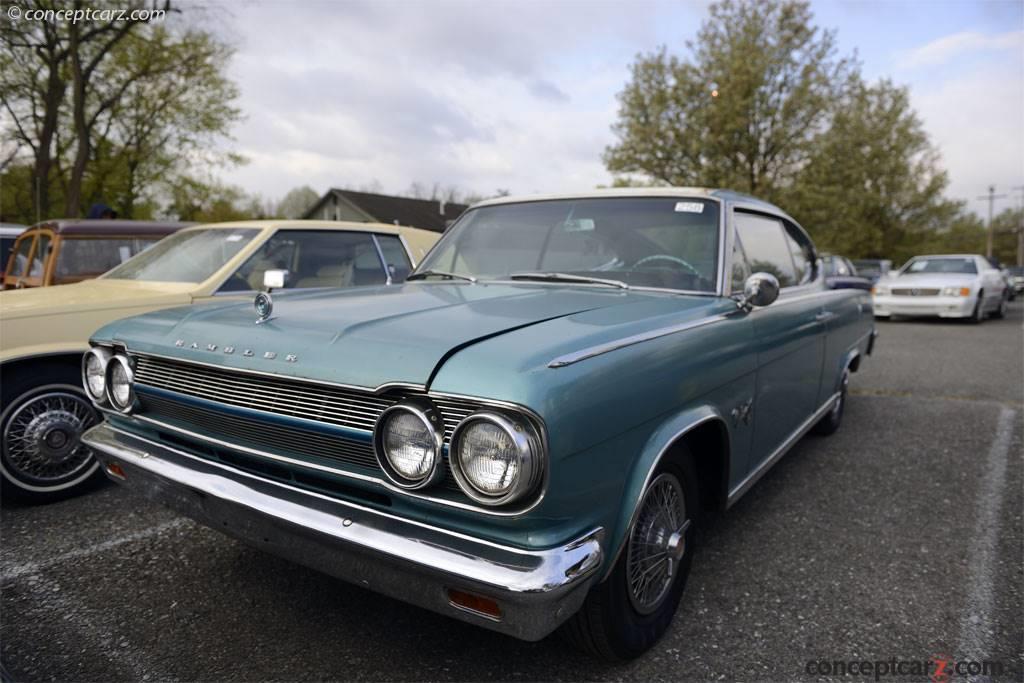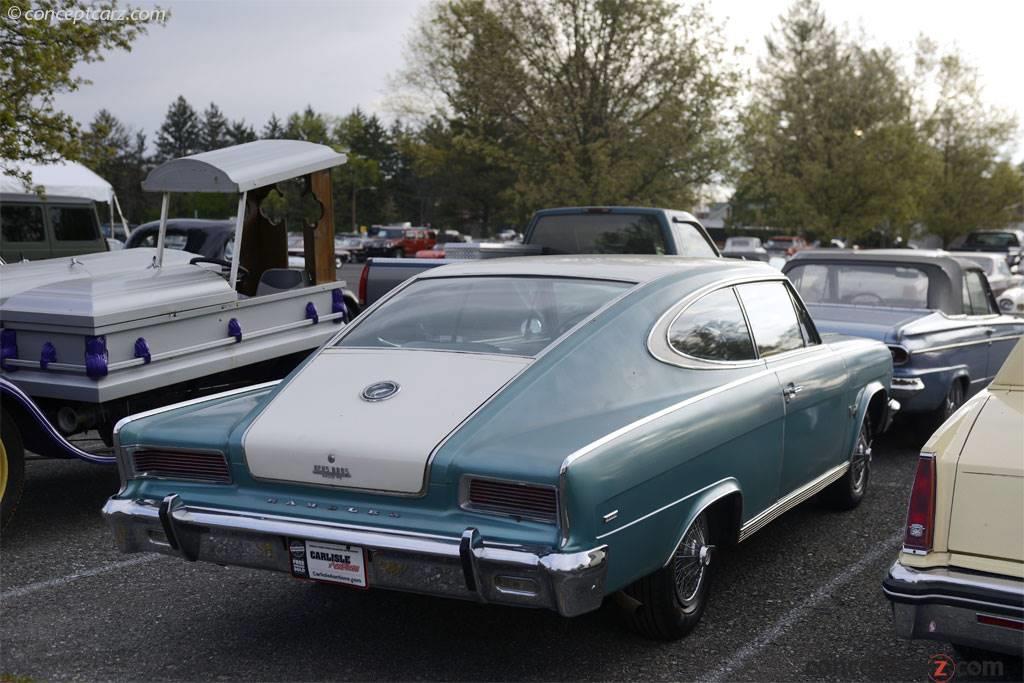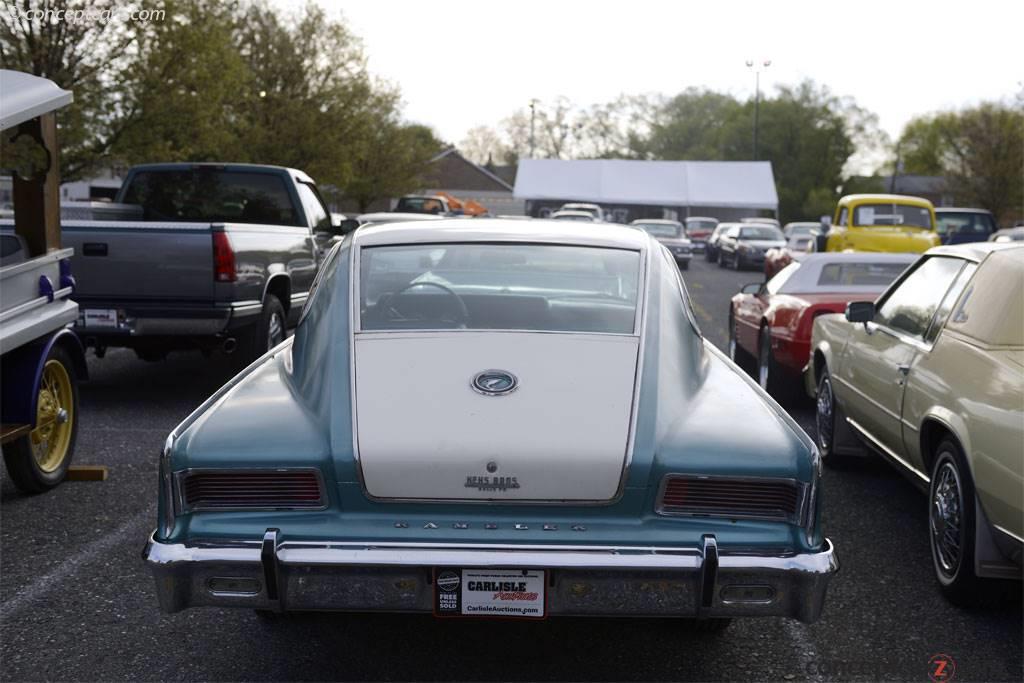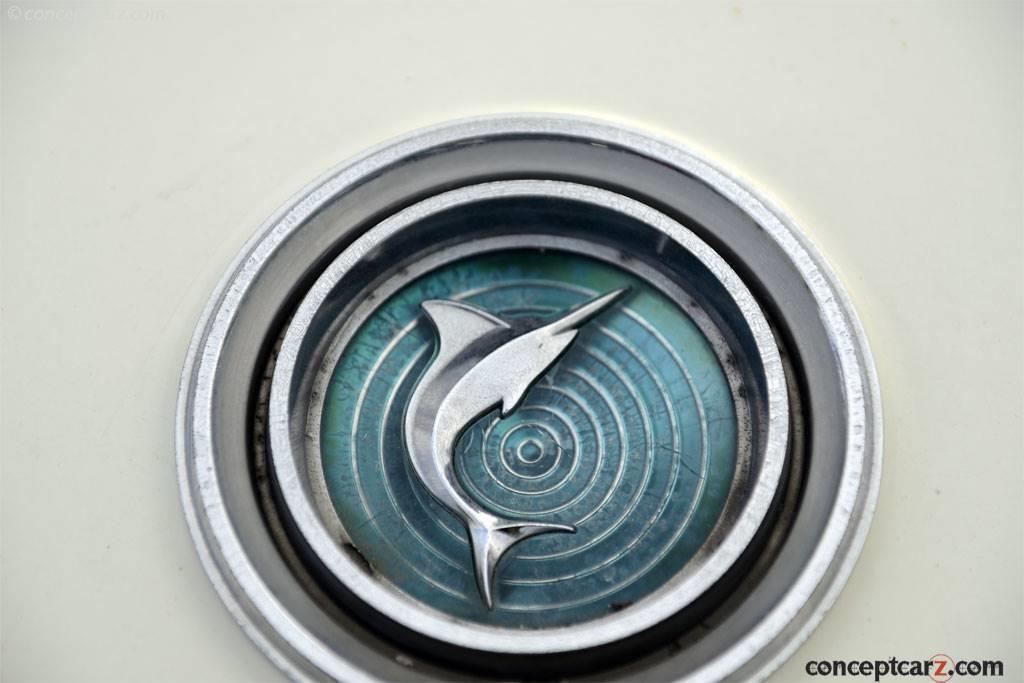The Marlin was promoted as 'The swinging new man-size sports fastback by Rambler.' Introduced as the Rambler Marlin in 1965 - and soon becoming the AMC Marlin - it was a two-door fastback that was a rather significant departure from the compact, economical cars that left the Rambler factory. It was a roomy, 6-passenger vehicle that had a sporty persona that appealed to the youth market. It was built on AMC's intermediate-sized Rambler classic platform and wore a design by American designer Dick Teague.
Hardtop Fastback
View info and history
Auction entries : 1The 1960s gave birth to the (and/or increased popularity of the) pony, muscle, and personal luxury segments. An increasing influence of younger buyers seeking a sporty image inspired manufacturers to shoe-horn large engines into compact platforms. The Marlin was Rambler/AMC's answer, providing a unique flavor that was a part sport, part luxury, and part utilitarian with its roomy, six-passenger seating. The company had built a four-seat fastback design study in 1963 called the Rambler Tarpon as a potential entry into the growing compact-sized market. It was a concept car that was shown at various auto shows as the company gauged interest. What they learned was that the current 'GEN-1' V8 engine would not fit into the engine bay, and the market would not be satisfied with a six-cylinder version alone. To accommodate the performance community, the decision was made to build the new fastback model on an intermediate-sized platform. Many of the design features of the Tarpon show car were incorporated into the Marlin, including the windshield, fastback line, and an iconic roofline. Roy Abernethy, who succeeded George W. Romney as the company's CEO, insisted the roof be raised over the rear passenger area to accommodate larger individuals (Abernethy, himself, was six-foot-four) and to make the back seat more useable. 
Hardtop Fastback
View info and history
Auction entries : 1The Marlin was built to follow the muscle car formula and as a personal luxury vehicle. It was equipped with a plethora of standard amenities and could be outfitted with numerous options. The standard engine was a 232 cubic-inch inline-6 with a two-barrel carburetor, 155 horsepower, and backed by a three-speed manual transmission. Overdrive, 'Twin-Stick' on the console, and a three-speed automatic were optional. A four-speed manual was added to the options list in 1966. Engine options included the 287 cubic-inch V8 with a two-barrel carburetor and 189 horsepower, a 327 CID 2-barrel V8 with 250 horsepower, and the range-topping, four-barrel version with 270 horsepower. All of these V8 engines had overhead valves, a cast-iron block, hydraulic valve lifters, and five main bearings. Stopping power was by front four-piston Bendix disc brakes, making the Marlin one of the first American automobiles with disc brakes as standard. In the back were drums without servo assistance. Optional performance features included power steering, heavy-duty suspension, and 'Twin-Grip' limited-slip differential.Zero-to-sixty took around 9.7 seconds with the 327 4-barrel V8 installed, and the quarter-mile in 17.43 seconds at 79 mph. The Marlin rested on a 112-inch wheelbase, had a length of 1965 inches, a width of 74.5 inches, and a height of 53 inches. It was officially announced on February 10th of 1965 and unveiled in Rambler dealer showrooms on March 19th. Each dealership received one or two examples to increase showroom traffic, and the company even sent bulletins to dealerships telling 'How to use Marlin to sell the Rambler Classic.'
Hardtop Fastback
View info and history
Auction entries : 1Standard amenities included reclining front seats, center armrests in the front and rear when bucket seats were installed, and interiors sourced from AMC's two-door Ambassador model. The door panels were finished with carpeting and stainless steel trim, and the dashboard was trimmed with engine-turned aluminum. The reclining bucket seats could be ordered with headrests, and retractable front seatbelts were optional. Optional amenities included 'Solex' tinted glass which proved popular as approximately 70 percent of Marlins were fitted with this feature and a choice of AM radio or an AM/FM monaural unit with 'Duo Costic' rear speaker and 'Vibra Tone' system to simulate stereophonic sound. Air conditioning, power windows, and an adjustable steering wheel were also part of the options list. The two-door Hardtop Fastback Marlin had a factory base price of $2,640 with a standard six-cylinder engine or $2,725 with the 287 V8. A total of 10,327 examples were built in 1965 with approximately 2,000 examples powered by the six and circa-8,300 with a V-8. 
Hardtop Fastback
View info and history
Auction entries : 1Compared to the Mustang which had seating for four occupants, the Marlin could accommodate six passengers. Its design was similar to the Rambler Classic but with the fastback roofline, a Marlin hood ornament, unique taillights, and a similar grille but devoid of vertical division bars. Production continued through 1967, with 4,547 examples built in 1966 and 2,545 in 1967. By 1967, the Marlin had become lower, longer, and wider plus had added two inches to its wheelbase. It continued to wear its unique fastback roof styling but with smoother bodysides, Rally lights in the grille, and a new rectangular gas filler door. It had become larger as AMC was preparing to introduce the compact-platform-based Javelin in 1968. Throughout its brief production lifespan, production remained exclusive, and despite its low sales, it succeeded in generating publicity and excitement for the company, attracting potential customers to AMC dealerships.
by Daniel Vaughan | May 2021

Hardtop Fastback
View info and history
Auction entries : 1

Hardtop Fastback
View info and history
Auction entries : 1

Hardtop Fastback
View info and history
Auction entries : 1

Hardtop Fastback
View info and history
Auction entries : 1
by Daniel Vaughan | May 2021
Related Reading : Rambler Rambler Marlin History
The AMC Marlin was a vehicle aimed at competing with a new breed of vehicles. Ford had their Mustang, Chrysler had the Barracuda, and General Motors had their pony cars such as the Camero and Firebird. AMC decided to enter this segment of the market with the Marlin, a vehicle that could best be classified as an intermediate sports sedan. Under the leadership and direction of Roy Abernethy, the AMC....
Continue Reading >>
Continue Reading >>
Related Reading : Rambler Rambler History
Introduced in 1950, the Nash Rambler was designed to be much smaller than other contemporary vehicles while still accommodating five passengers easily and comfortably. Produced by the Nash Motors division of Nash-Kelvinator Corporation for six years only, the Rambler was responsible for establishing a new segment in the automotive market. Widely considered to be the original modern American compact....
Continue Reading >>
Continue Reading >>
Related Reading : Rambler Rambler History
Receiving quite an elite status, the Rambler nameplate is responsible for leading the North American auto industry into smaller, more economical vehicle, which eventually received the identity of ‘compacts. Various companies attempted to build smaller vehicles following the war, with little success. The Nash Kelvinator Corp. of Kenosha, Wisconsin was the one to introduce the first ever compact,....
Continue Reading >>
Continue Reading >>
Rambler
Similarly Sized Vehicles
from 1965
Similarly Priced Vehicles
1965 Rambler Marlin Vehicle Profiles
Recent Vehicle Additions
Performance and Specification Comparison
Price Comparison
Rambler Marlin Specification Comparison by Year
Year
Production
Wheelbase
Engine
Prices
10,327
112.00 in.
6 cyl., 231.90 CID., 145.00hp
8 cyl., 287.00 CID., 198.00hp
8 cyl., 287.00 CID., 198.00hp
$2,640 - $2,640
118.00 in.
6 cyl., 232.00 CID., 145.00hp
8 cyl., 287.20 CID., 198.00hp
8 cyl., 290.00 CID., 200.00hp
8 cyl., 287.20 CID., 198.00hp
8 cyl., 290.00 CID., 200.00hp
$2,670 - $2,670
Related Automotive News

Excellence Reborn – Work Under Way On Iconic DB4 GT Zagato Continuation
First body completed as DB4 GT Zagato Continuation build commences at Aston Martin Works
Modern production systems meet artisan coachbuilding skills as Aston Martin optimises Zagato build process for 21st Century
DB4 GT Zagato Continuation extends...

DBZ Centenary Collection: Classic Joins Contemporary In Unique Centenary Tribute
DBZ Centenary Collection comprises of DB4 GT Zagato Continuation and DBS GT Zagato
Production strictly limited to 19 pairs - cars will not be sold separately
Conceived to mark Zagatos centenary in 2019
Track-only DB4 GT Zagato Continuation to be...

DB4 G.T. CONTINUATION: HISTORY IN THE MAKING
Iconic DB4 G.T. brought back to life by Aston Martin Works
Cars will be built at Newport Pagnell - home of the original DB4 G.T.
Strictly limited to 25 track-only cars
Newport Pagnell production re-starts after 10 years
09 December 2016, Newp...

Thomas Scott Collection of Classic American Automobiles to be On Offer at No Reserve at Russo and Steele's 2015 Monterey Collector Automobile Auction Event
Scottsdale, Arizona (July 18th, 2015) – Thomas Scott is an accountant and entrepreneur from Athens, Georgia who has had a love for all things automotive for as long as he can remember. He possesses a lifetime of passion for buying, selling and...

Holden Celebrates 35 Years of Commodore
Holden is celebrating the 35th anniversary of its most iconic nameplate, Commodore.
For over three decades, the Holden Commodore has delivered significant advances in vehicle performance, safety and comfort on the way to becoming Holdens longest-standing...















